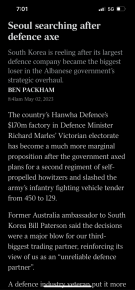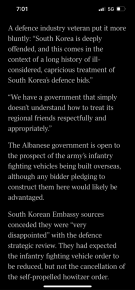And here we hit a significant professional frustration of mine. I should be able to provide you a link to the Army's answer to this, complete with linkages, thoughts and colourful pictures. Unfortunately...we haven't done that actual work. Personally I think that we should have because half the arguments about kit go away - because between strategy and role there is a clear plan...
Anyhows...
Straight up - my apologies to anyone I'm telling to suck eggs. And this isn't aimed at
@Bob53 at all, I'm simultaneously using his question as a springboard and semi-professionally venting. And, because they complicate everything and not part of the ADF, I'm ignoring nukes.
The role of the Army, on the surface, is quite simple. Fight and win the land battle. Easy. Any questions?

Ok, there are two that need to be answered. What and why. Starting with the harder one...
Why? Why have a land battle? It's an excellent question, the casualties and destruction are brutal. The cost in every definition is high. The reason boils down to something really simple, humans live on land and are supported by the land. To understand that you need to go back to basic definitions - what is the purpose of war? That, again, is inherently simple: to compel the enemy to our will. There are two ways to guarantee this, the complete annihilation of the enemy or putting a force into their cities and villages to force them to our will. The first is unacceptable (and arguable), the second requires a land force.* And the key to a nation is the people. Look at our troubles in Iraq and Afghanistan - large parts of which boil down to us ignoring the population and focusing on 'leadership'. In a simple analogy, does Collingwood draw its support from the general population or a collection of elites like McGuire?
Now, we are a free, fun loving democracy. Do we need the power to compel an enemy? Frankly, yes. Because our will (rules-based global order (I know...)) conflicts with others. That conflict could be major (Japan in 1941) or minor (Somalia in 1992) but it's wherever our Government of the day decides. That's where the critical strategic documentation starts - it lays out our national interests, what and where we draw lines and what we expect in the world. It is also multi-departmental; compelling the will of another nation needs more than an occupying force (Afghanistan in 2020).
So what is the what? If the why to have a land battle is to compel the will of a nation, well, what is a battle? Immediate answer is something like Kursk in 1943. Tanks, air support, artillery, infantry all attacking with lots of noise and explosions. Except, that's at one end. A battle is simply a conflict between two opposed forces. It certainly is Kursk in 1943, but it's also Fallujah in 2004. Or Kibeho in 1995. It's what we do to push the 'enemy' out of the towns to enable us to compel the populous. And that's where it gets hard for an Army. Because sometimes the enemy doesn't fight, or at least doesn't fight us. Timor Leste in 1999, the Solomon's in 2000, Cambodia in 1994 - the peacekeeping/making and low-level war is tricky. Sometimes, our will and the foe's is really similar. Hussein and Bush both wanted peace in Iraq and no security threats. separating those two often requires more than simply guns (remember, annihilation is not an option), it requires time, understanding and presence. Hence why very few shots have been fired in Timor-Leste/Solomons, but the Army has been there for years.
The critical part here, and where the what links to the why, is persistence. Humans are stubborn beasts - you don't have zero Nazi's in Germany in Jul 45 despite the destruction of their nation. Hell, you still have Nazi's today. To influence the will you need to be there. Lots. To be there you need to seize and hold the ground. That last part is vital - if you don't hold you don't compel. By definition there is only one thing that can do that, and that's the infantry. Now, they are adorable critters, but very squishy, so they need help.
While simple on the surface, it's the very breadth that complicates matters. An Air Force or Navy cannot influence a population** like an Army can. And that's regardless of intensity. We could have all the SSN and F-35 in the world, they cannot go into Dili and stop the gangs. They cannot go into Honiara and escort an election monitoring team. They cannot seize and hold Villers-Bretonneux and prevent German schools/banks/post offices. They can help for sure, I want RAN SSNs sinking every bloody supply ship and I want to fight in the shade RAAF F-35s make, but they cannot seize and hold. They cannot have the presence required to compel.
So to sum it up, the role of the Army is to seize and hold population centres against threats to compel 'them' to agree with Australia's views as determined by Canberra.
See....simple.
That is unchanging and enduring. It's as accurate now as it was in 1914 as it will be in 2065. Humans are humans.
The tricky part for 'IIP-stuff' is in the breadth of that. Look at the examples I've given above, they range from one end to the other. Partially because of their environment and partially because of their mission, Air Forces and Navies have it simple. Arguing that you need a Sqn of this, or a TF of that is easy because they all build on simple building blocks. Fighters fight in pairs, preferable two pairs at a time. So every F-35 unit is based on 4. DDGs fight in pairs, so you need 2. And, while called multirole, these platforms are pretty specialised. They are also expensive, so you have to be careful when committing them.
But what is the 'so what' for an Army? The answer to the Solomons in 2000 is a very different answer to Iraq in 2003. Both are very different to Kokoda 2042. Or Beersheba in 2038. Or Binh Ba in 2035. Those forces are so completely different they might as well be two Armies - but we cannot afford that.*** The other thing is, the fundamentally, unalterable national interest that the Government must maintain is the security of the Australian population. Which means you need an Army capable of the big fights, because the ADF is an insurance policy to ensure that. And even then, that kit will be useful. If you think IFV, SPH, CRV will not deploy in INTERFET Mk 2 - they will. Even ragtag gangs have first line weaponry nowadays - especially if unfriendly nations set up proxies. We don't fight fair - fair is where every Australian comes home. And rolling in big, mean and fast has one hell of a psychological impact. The perception that our heavy kit is only for use against Beijing is aggravating - how likely is a PRC-back militia going to open fire on an IFV with APS, overwatch and rapid fires in support versus a dismounted patrol? Remember - compel the will of a nation. Deterrence

is part of that, it's compelling without fighting, which further means we need to be hard hitting and resilient.
And that's where my peers have let us down. Explaining in simple terms, with glossy photos and examples, linked back to enduring ideas. If you haven't had the chance, read
The Navy and the Nation. It's an excellent piece of work and it sat on the bedside table of three Prime Ministers. It did more good for Navy than almost any project or $$ did. So where is the Army's equivalent?
Anyhow...wandering now. Hopefully that answers the question and gives some insight into the so what. Armies are fundamentally essential to the conduct of war and the defence of the national interests. They need help, (and we are an island nation), so the RAAF and RAN are also vital. But undermining the Army undermines the ADF and the national interest.
---
* There have been 2.5 cases where this has not been the case. The first two, Japan 1945 and Berlin 1948, cannot be done with the mass Australia has and required unique circumstances unlikely to be repeated. The 0.5 is Kosovo, where I tend to believe the threat of ground forces pushed the result, not the questionable 80-odd day air campaign.
** Unless you are the RN in 1918 or the USN in 1945 - and you are against geographically constrained foes. And even then, you need land forces to be applying the pressure that a blockade exacerbates. Sanctions alone do not work.
*** Of note, every operation except two conducted by the Australian military since 1901 (err....I don't know about Southern Ocean fisheries/rescuing yachtsmen (were they operations though?)) has had a Land component or been in direct support of Land Forces. While loathe to use "we haven't used it since 19xx so don't need it", that reflects the importance and centrality of putting forces into enemy towns to compel their will. The two exceptions were Berlin 1948 (which is actually evidence as to why we should have 3x 36 Sqn and 1x 75 Sqn, not the other way around) and the strategic bombing campaign over Germany in 1940s. Which underscores the unique role of the infantry, because we never compelled a single town to our will. Every town we bombed still needed ground forces to go in and hold it. If you don't commit land forces, you will ultimately end up needing to which comes back to needing a prepared and capable Army.



 apple.news
apple.news


